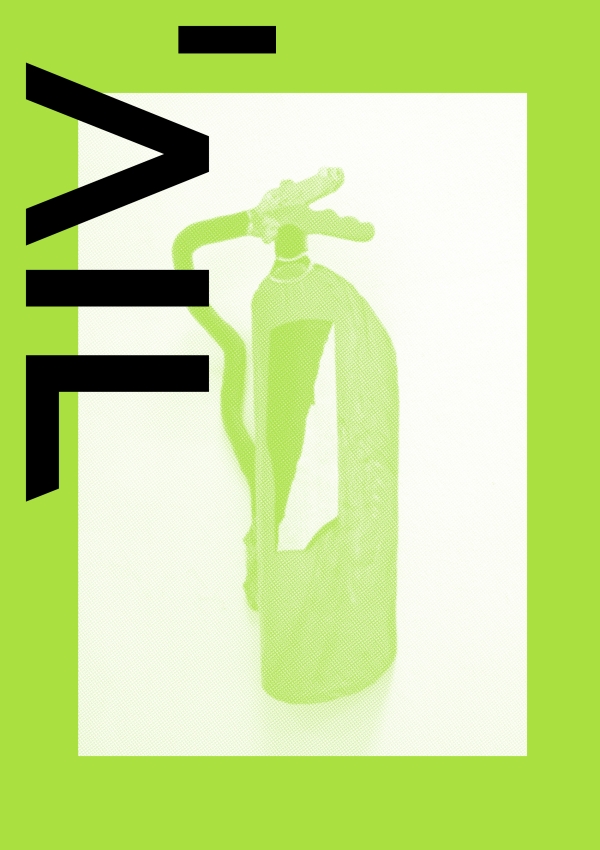AIL Ping-Pong #2: Sample
Showcase of artistic projects by Angewandte
alumni

Rafael Lippuner, o.T. (Feuerlöscher XI), 2025, Studioansicht 1
Presented in the small vitrine of the Otto Wagner Postsparkasse, seven graduates of the University
of Applied Arts Vienna open a window into the diverse artistic practices and languages of Angewandte alumni, offering a range
of perspectives that explore parallels, contrasts, or extensions within the given thematic framework.
Intervention at Counter 13 with Hubert Blanz, Margareta Klose, Marlene Lahmer, Rafael Lippuner, Mona
Rith, Laura Stoll and Martin Veigl
In its second edition, AIL Ping-Pong circles around the term and meaning of
“sample.”
While in the natural sciences, samples are collected to enable analysis and investigation, in music,
the term “sample” refers to an excerpt from an existing recording that is integrated into a new composition. Similarly, in
the visual arts, samples may emerge throughout the creative process – whether through experimental methods, the appropriation
of external content, or the incorporation of elements from other disciplines, methodologies, or conceptual frameworks. Ideas,
materials, methods, or visuals can be sampled. A sample can thus represent transdisciplinary collaboration or reflect a dynamic,
exploratory process marked by iteration, testing, and discovery.
Hubert
Blanz graduated in 1999 from the Department of Sculpture (Bildhauerei). His artistic work deals primarily with
urban infrastructures, spatial grids, and geographical and virtual networks. Within this context, megacities have emerged
as a central theme: the rapid and constant development, the challenges and visions that accompany them, and the influence
of these changes on our coexistence. In addition to elements of the big city, networks from nature also serve as templates
for large-format collages and animations.
Margareta Klose explores topics of coexistence
within a queer-feminist, poetic practice. Her artistic work and research are situated at the intersection of fine arts, literature,
education, knowledge production, and memory – centered around painting, writing, computational photography, and objets trouvés.
In her work, she develops site-specific installations and performances that resemble cabinets of curiosities, scientific experimental
settings, and artists’ studios – or rather: alchemists’ kitchens. At the University of Applied Arts Vienna, she studied in
the Department of TransArts and graduated in 2020.
Marlene Lahmer’s work is material-based and
takes the form of sculptures, multimedia installations, and text performances. Literary and theory-informed approaches overlap
translucently, incongruently, and at times complementarily. One of her main focuses lies in the aesthetic and physical qualities
of glass, in the visual and auditory spaces found for texts, and in exploring concepts from cultural theory and linguistics.
Lahmer graduated in 2022 from the TransArts department.
Rafael Lippuner is an artist and
exhibition designer who employs the processes of assembling materials, installing, and managing as artistic practices. The
means of presentation are linked to the role of objects in terms of interaction and storytelling – especially in a time when
images and symbols displace language. His multimedia works sample and intervene in everyday situations, structures, and codes
to retain a certain wilderness in how we perceive our surroundings. In 2019, Lippuner graduated from the Department of Art
& Science.
Mona Rith is a textile artist, who weaves abstract objects and explores the
possibilities between fixed structures and the limits of their dissolution. She plays with tension, shrinkage, and other material
behaviors through weaving techniques combined with the inherent properties of the materials used. With great curiosity, Rith
observes and investigates dependencies, interactions, and connections. She is an alumna of the Institute of Studies in Art
and Art Education and graduated in 2021.
Laura Stoll works in the fields of sculpture, installation,
and performance. After earning a degree in medicine in Berlin, she graduated from the University of Applied Arts Vienna in
the Department of Art & Science in 2021. In her projects, she operates at the intersection of medicine, psychology, and
philosophy, applying individual methodologies from these fields to her artistic practice. Using a variety of formats, she
investigates questions of personal identity and what constitutes our sense of being.
Martin Veigl is
a painter, interested in the smallest gestures and daily situations that convey social and historical codes and messages.
Each found configuration can be seen as an unconscious, natural, and authentic fragment of reality. His paintings often do
not fill the entire canvas, are fragmentary in nature, and suggest moments of memory. Veigl graduated from the Department
of Painting in 2016. 



